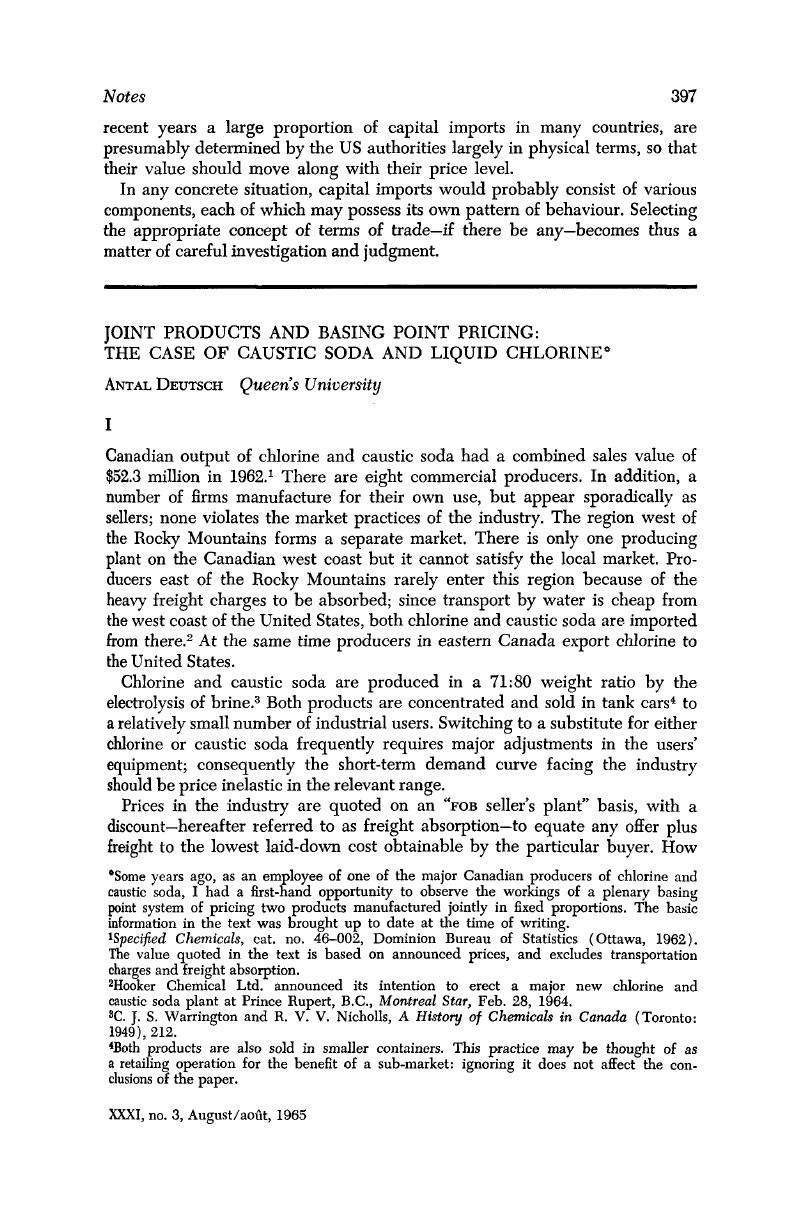Article contents
Joint Products and Basing Point Pricing: The Case of Caustic Soda and Liquid Chlorine*
Published online by Cambridge University Press: 07 November 2014
Abstract

- Type
- Notes
- Information
- Canadian Journal of Economics and Political Science/Revue canadienne de economiques et science politique , Volume 31 , Issue 3 , August 1965 , pp. 397 - 401
- Copyright
- Copyright © Canadian Political Science Association 1965
Footnotes
Some years ago, as an employee of one of the major Canadian producers of chlorine and caustic soda, I had a first-hand opportunity to observe the workings of a plenary basing point system of pricing two products manufactured jointly in fixed proportions. The basic information in the text was brought up to date at the time of writing.
References
1 Specified Chemicals, cat. no. 46-002, Dominion Bureau of Statistics (Ottawa, 1962).Google Scholar The value quoted in the text is based on announced prices, and excludes transportation charges and freight absorption.
2 Hooker Chemical Ltd. announced its intention to erect a major new chlorine and caustic soda plant at Prince Rupert, B.C., Montreal Star, 02 28, 1964.Google Scholar
3 Warrington, C. J. S. and Nicholls, R. V. V., A History of Chemicals in Canada (Toronto: 1949), 212.Google Scholar
4 Both products are also sold in smaller containers. This practice may be thought of as a retailing operation for the benefit of a sub-market: ignoring it does not affect the conclusions of the paper.
5 “Olin Mathieson Chemical Corp. has reduced the price of liquid chlorine in the United States. …” “Two other U.S. producers, Dow Chemical Co. and Wyandotte Chemical Corp., announced they would meet Olin's price cuts.” “Spokesmen for two major Canadian chemical producers, Canadian Industries Ltd. and Dow Chemical of Canada Ltd. said they were studying the move. A third producer, Standard Chemical Ltd. said: ‘We are not contemplating any change in price.’” Globe and Mail, 12 5, 1964.Google Scholar
6 “Phantom freight” is a fictitious transportation charge from the nearest basing point, when the actual shipment originates in the proximate non-base mill.
7 In assuming a given pattern of competitive behaviour with zero conjectural variation, the firm behaves like Cournot's mineral spring proprietor. Cournot, Augustin, Researches into The Mathematical Principles of the Theory of Wealth, trans. Bacon, N. T. (New York: 1929), 79ff.Google Scholar
8 Clark, J. M., in “The Law and Economics of Basing Points: Appraisal and Proposals,” American Economic Review, 1949 Google Scholar, develops the concept of mill net curves but errs in labeling them demand curves facing the firm.
9 A not-too-promising approach to the problem of caustic soda and chlorine surpluses in the US is reported in The Wall Street Journal of December 7, 1964.
“Olin Reduces Chlorine, Caustic Soda Price; Cuts, to Paper Firms, Being Met by Rivals Olin Mathieson Chemical Corp., New York, cut the price of liquid chlorine by $6 a ton and liquid caustic soda by $5 a ton. The reductions apply only to customers in the pulp and paper industry.… Pulp and paper makers have an advantage in buying these two chemicals because they purchase roughly equal amounts of each. Thus, there have been reported offers of unit prices, or one quote to cover both chemicals. Most users take one or the other but not both equally. …”.
10 Cross-hauling adds to railroad revenues. As one Canadian railroad has its operating deficits compensated by the federal treasury, part of the private cost of cross-hauling is captured by the public purse.
Government subsidies to railroads conditional on the maintenance of low freight rates, lead to lower freight absorption, to more cross-hauling, and to higher profits for basing-point sellers.
11 An illustration of a public announcement was printed in the September 16, 1963, issue of the Montreal Star:
“Construction of a new $7,500,000 chlorine and caustic soda plant at Hamilton, Ontario by Canadian Industries Limited … was announced today by J. D. Wright, general manager, chemicals. … Mr. Wright stated that this will be the fourth C-I-L unit to manufacture chlorine and caustic soda. Others are located at Cornwall, Ontario; Shawinigan, Quebec; and a third plant is just being completed at Dalhousie, N.B. Our purpose in decentralizing production of these basic chemicals is to improve service and minimize cost to our customers, he said.”
12 A good exposition of this viewpoint, along with the history of basing point pricing in the US can be found in The Basing Point System, by Machlup, Fritz (Philadelphia, Toronto 1949).Google Scholar
13 Kaysen, Carl, in “Basing Point Pricing and Public Policy,” Quarterly Journal of Economics, vol. XLIII (1949), 289–314 CrossRefGoogle Scholar, examines the issue of local monopoly against basing point pricing and concludes that the former has no absolute claim to superiority from the social point of view.
14 Macnlup, The Basing Point System.
15 In a number of combines cases involving basing point pricing, convictions were sought and obtained on the explicit evidence of conspiracy in restraint of trade. The Crown introduced the existence of basing point pricing in a merger case, Regina v. The British Columbia Sugar Refining Company et al. Mr. Justice Williams, of the Manitoba Court of Queen's Bench, dismissed the pricing issue by saying, in part, “… The merger complained of had nothing to do with the adoption, years ago, or with the continuance of use of the basing price method after the merger. …”
- 3
- Cited by


